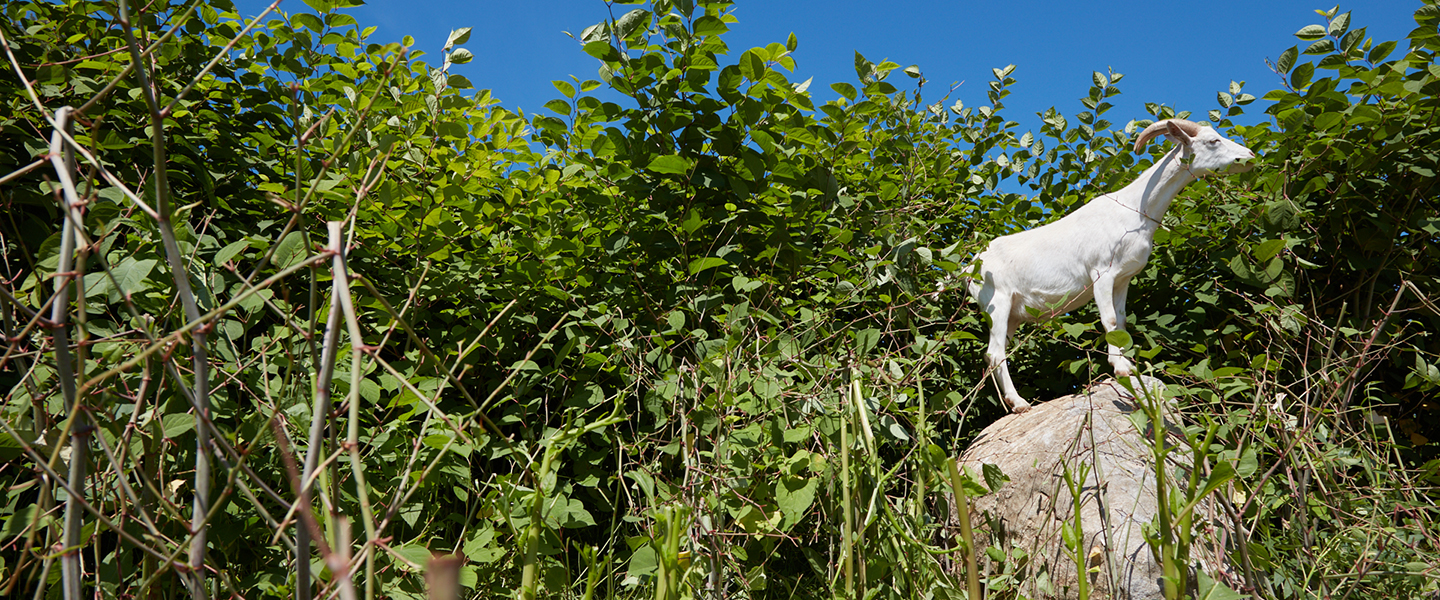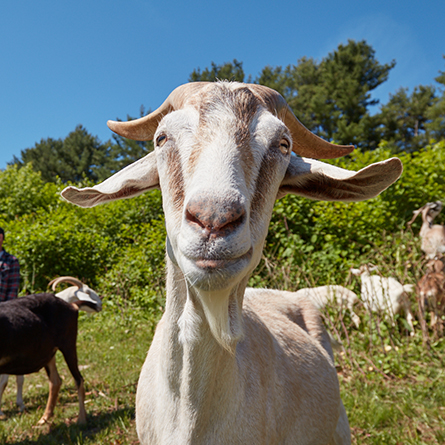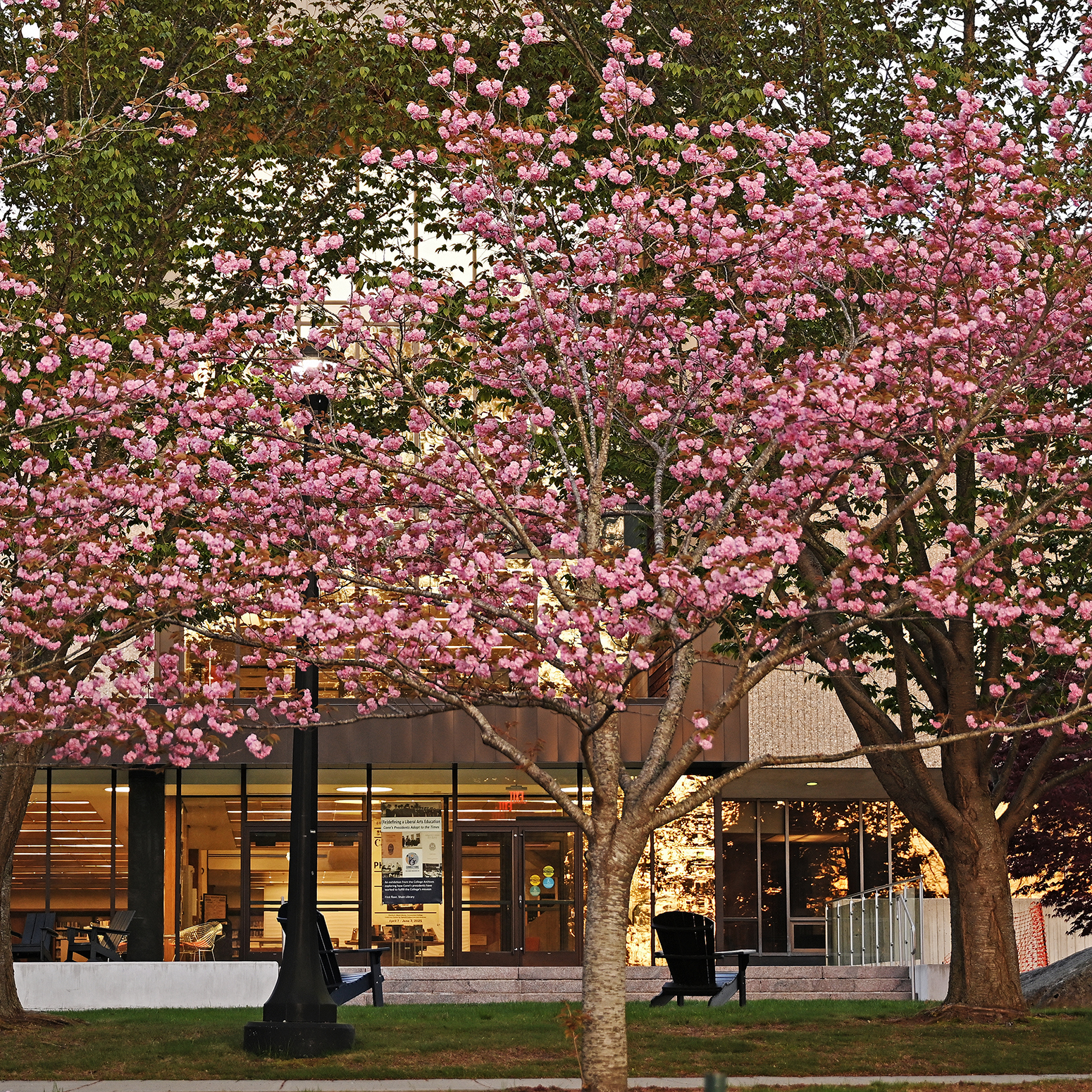
Knotweed dispensary
Rhode Island–based Herd of Hope brought its eager goats to campus in June to gorge on invasive knotweed.
The goats hoofed off the old school bus ready to work. Presented with an all-you-can-eat buffet of the aggressively invasive knotweed that flourishes around the Athletic Center, the herd wasted no time munching away on what, to their refined palates, is an irresistible delicacy.
The herd of hungry ruminants browsed happily along the slopes surrounding the Athletic Center for several days in June, part of an invasive-plant-management plan that began as a hypothetical idea in a senior integrative project crafted by Shefka Williams ’21 through the Goodwin-Niering Center for the Environment. Williams was interested in exploring sustainable grazing and browsing techniques for landscaping and finding alternatives to pesticides.
“We had an ecological issue going on down at the Athletic Center with a lot of invasive species, so we decided to design a hypothetical grazing-management plan to see how we could take care of some of these invasives and favor some native species to establish on these hillsides,” said Visiting Assistant Professor of Botany Eric Vukicevich, who worked with Williams on the project.
The feisty goats, with their seemingly endless appetite for troublesome weeds, were provided by Rhode Island–based Herd of Hope. Located on Laurel Hill MicroFarm, a 28-acre farm established in 2010, it functions as a goat refuge and sustainable landscaping service.
Unaware of the environmental good they’re doing, the goats are quite willing participants, “volunteering” for each project (if an individual goat doesn’t feel like getting on the school bus, it’s not forced to go). Renowned for their climbing prowess and insatiable curiosity, the goats are contained within a set perimeter with a temporary fence and are monitored 24 hours a day by the herder and co-owner, Wayne Pitman, who sleeps on the school bus on-site. A hose attached to the Athletic Center delivered water to the herd.
Lawn mowers are notoriously deficient in tackling hills and steep inclines—an obstacle the sure-footed goats shrug off. And the spread of invasive plants such as knotweed, often exacerbated by mowing, is almost entirely arrested by the “goat-scaping” technique, thanks to the goats’ unforgiving digestive system.
“Goats are really effective at clearing because when they eat the plants that they eat, they kill the seed because they have a very acidic rumen that processes food to the point where 99.8% of the seed that comes out the other end is not viable,” explained Pitman.
Pitman pointed out that knotweed is particularly adept at exploiting mowers, as it’s a self-planting species that spreads through a cloning process. While most plants reproduce by a scattering of their seeds, new knotweed plants crop up from pieces of other plants that have broken free and established roots. Their greatest foe, then, may well be the bearded, bleating weed-whacking goats that find the knotweed so delicious.
“When goats eat it, they leave the stock dry and dead, so it can’t move on and create a new outcropping of the knotweed,” said Pitman. “When you mow, you create 20 new plants. Every time you mow over a stock, that cuts it up into small sections and spreads it out to the rest of the lawn. Goats eat it in place and allow it to dry. It’s dead. And it doesn’t spread.”
Goats have served as a vital resource for humans for thousands of years. Archeological findings suggest that Neolithic farmers were the first to domesticate the mischievous beasts, about 9,000 years ago. Meat, hides, milk, cheese, bones and fur are all resources from the animal that were utilized by ancient cultures and remain desirable today.
While goat cheese is popular in the west, the meat has largely fallen out of favor. But it’s still considered a staple in many countries, resulting in close to half a billion goats each year being processed for their meat.
With a life expectancy of 15 to 18 years, Pitman’s goats have a solid 12 years of heavy leaf munching for goat-scaping purposes. Then they retire to a life of leisure and reflection on the farm. The organization has herds for projects large and small. For physically demanding jobs, the full-grown male goats, with their ravenous appetites, are most efficient. But for smaller, residential clearing and landscaping jobs, the younger and less gluttonous among the herd are chosen.
“This is the first year that we’re trying this, and we hope to use the goats for the next couple of years,” said Miles Sax, the Charles and Sarah P. Becker ’27 Arboretum Director. “It’s a process that we know will take time. This is a great solution that’s sustainable, that doesn’t use chemical controls and pesticides, and something that aligns well with our sustainability goals at the College.”


